The Palace of King David
King David is one of the most celebrated figures of the Hebrew Bible, his name mentioned more often than even that of Moses. According to the Bible, David united the 12 tribes of ancient Israel into a great kingdom stretching from Egypt to Mesopotamia, with Jerusalem as its capital. Yet some scholars today question whether this kingdom—and even David himself—ever existed. In the mid-1990s, Israeli archeologist Eilat Mazar proposed searching for the remains of David's palace at a site in the oldest area of Jerusalem. A decade later, with the support of the Shalem Center in Jerusalem, she realized this dream. In this interview, hear about her remarkable finds.
 While
the historic King David remains
elusive, Mazar's excavation, as it
continues to unfold, may shed more
light on this legendary leader.
Photo credit: © Art Resource
While
the historic King David remains
elusive, Mazar's excavation, as it
continues to unfold, may shed more
light on this legendary leader.
Photo credit: © Art Resource
Biblical clues
Why did you want to excavate here, in this part of Jerusalem?
Eilat Mazar: We started excavations here because we wanted to examine the possibility that the remains of King David's palace are here. We could have been wrong, but we knew that whatever we would find would likely be important. We are in a very important spot of the City of David [the oldest part of Jerusalem], at the top of the city. It overlooks all the area around, and it's very narrow, only about 60 meters [about 200 feet] wide.
Were there clues in the Bible that this might be the spot of David's palace?
Yes. We knew from the Bible that King David went down to a fortress as he heard the Philistines coming to attack him. Now, where did he go down from? Most probably from where he stayed, meaning his palace.
Before our excavations, it was believed that the Stepped Stone Structure [a 60-foot high, terraced structure] here was a support structure for the fortress of Zion, a Canaanite fortress that, according to the Bible, King David captured. Our idea was to excavate just to the north of where we thought the fortress was built.
Did archeologists before you think this area had remains from the time of David?
Some did. In the 1960s, for instance, Kathleen Kenyon's excavation revealed building remains and pottery indicating that a significant structure was built here in the 10th century B.C., meaning more or less around the time of King David [according to the biblical chronology].
When you started your excavation, what was the first sign that you had found something important?
We began to see signs that we were dealing with a very massive structure. Huge boulders started to appear all over the area. And we found walls that were very thick, more than five meters [about 16 feet] thick. I thought it was probably the remains of the fortress, not David's palace. Then, a week or a week and a half later, we started to find a lot of pottery from the 12th or 11th century B.C. in different places under the massive structure. So it couldn't be the Canaanite fortress of Zion, because the fortress would have been built hundreds of years earlier.
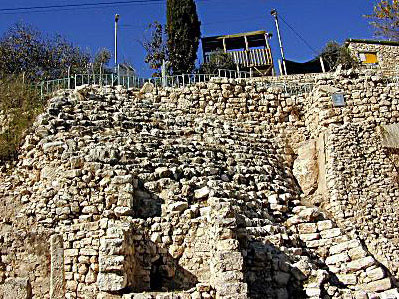
Mazar believes the Stepped Stone Structure once helped to support a huge palace complex built into the hillside. Photo credit: Courtesy Todd Bolen/BiblePlaces.com
So you found pottery under the structure, and then you also found pottery on top of the structure, is that right?
Yes. And this pottery together helps us to date the structure. So, under the structure we found a great quantity of pottery that is typical of the 12th–11th century B.C., the late Canaanite pottery. And on top of the structure we found later pottery, typical 10th-century pottery. The structure stands in between these two periods, meaning the building itself must have been built sometime around 1000 B.C.
Is it possible that the dating of the site could be off, that the structure might have been built earlier or later than the time of David and Solomon?
In archeology, it's very difficult to declare such a precise date. I say that the structure was built around 1000 B.C., but it could have been built 50 years before or 50 years after. It's a possibility, although it doesn't make sense to me to prefer these other dates, and I think it's important to take into account the biblical story of King David.
Signs of royalty
Does the pottery you found that you are dating to the 10th century look like the pottery of a palace?
It's beautiful, elegant pottery, certainly a prestigious collection. We also found ivory, including the handle of a knife probably, and most people didn't have ivory at that time. This was not a regular house.
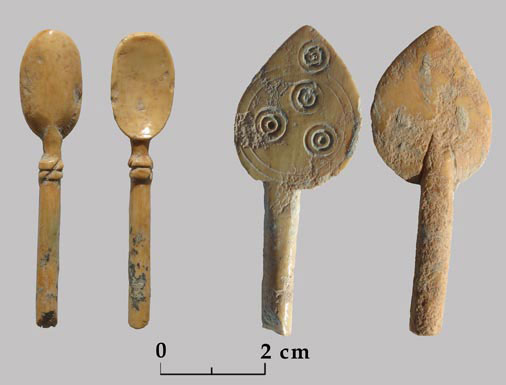
No ordinary household, Mazar says, would have carved ivory, but a royal palace likely would. Photo credit: Courtesy the Shalem Center
Do you now see the Stepped Stone Structure as part of this massive structure you are dating to the 10th century B.C., around the time of David?
Yes. We now see it as part of a huge structure. We are talking about a very complicated and highly skilled plan of construction. There are massive walls on the top, and because the bedrock here is very steep and cracked, these walls needed massive support, and the Stepped Stone Structure offered that support. So the Stepped Stone Structure was not built for a Canaanite fortress; it was built as one unit with the structure that we believe is the palace.
"The question is, how much of the reality that the Bible describes can we archeologists reveal?"
How much of the palace complex have you found—assuming, of course, that it is a palace complex?
The area we excavated occupies less than one-quarter of an acre, and it seems to be only about 20 percent of the whole structure at the top of the City of David. [Work subsequent to this interview has uncovered roughly 10 percent more.] So this is a huge structure, the largest ever found in Israel from the ancient Israelite period.
What convinces you that the structure is a palace?
Such a huge structure shows centralization and capability of construction. It can only be a royal structure. The question is, what kind of structure is it—a fortress or a palace or a temple? We conclude it's a palace because the Bible reports very clearly that such a palace was built. We showed it's not a Canaanite fortress, and we have no indication that another fortress was built. And we know there was a temple on the Temple Mount [north of the site] from that period.
A kingdom doomed to destruction
In light of your discovery, how would you describe Jerusalem at the time of David and Solomon?
It seems to me that Jerusalem at the time of King David and King Solomon was very much like the Bible describes. It was monumental; the constructions were massive. They used the Phoenicians, with their capability and skill, to build the largest structures ever built in Jerusalem: the temple, the two palaces—King David's and later the palace of King Solomon—and the wall of Jerusalem around these structures. This was a new wall that King Solomon added to the ancient wall of the old Canaanite town.
So was Jerusalem the capital of a kingdom as described in the Bible?
King David captured a Canaanite town that was very centralized, very important. He most probably did so purposely and didn't kill most of the people. He continued most of the existing administration. It gave him strength. I believe that Jerusalem continued to be a great metropolitan center and to serve as the capital of the Israelites.
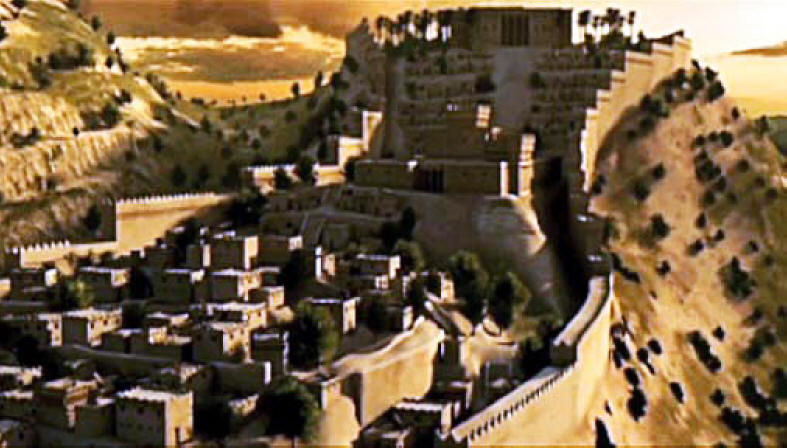
ANCIENT TSIYON? Drawing on Mazar's work, NOVA's filmmakers envisioned what the palace complex might have looked like. Photo credit: © WGBH Educational Foundation
How did the palace of David come to an end? Have you found evidence in your excavation?
We do not yet have clear evidence of the destruction. We may in future seasons. But I believe that it was part of the great destruction of Jerusalem in 586 B.C. by the Babylonians. We have lots of other evidence of this destruction nearby.
What was some of the first evidence of the destruction that you and other excavators found in nearby areas?
At the beginning of the 1980s, Professor Yigal Shiloh, a mentor of mine, excavated an area that includes what is known as the Burnt Room and the Bullae House. In their destruction layer, he found pottery typical of this period together with arrowheads that show that some fight was conducted here. It really revealed the destruction of Jerusalem by the Babylonians in 586 B.C.
And more evidence for the invasion and destruction has also emerged, is that right?
Yes. In my excavations at the Ophel, to the south of the Temple Mount, I discovered a royal structure that appears to have been destroyed by an immense fire around 586 B.C. As we excavated, our hands were black with the ashes. And the Bible tells us that the Babylonians set houses on fire.
Evidence of a biblical scribe
Tell me more about the Bullae House. Why does it have that name?
We think it was likely a royal archive. It has the name Bullae House because Shiloh found there, in addition to pottery and arrowheads, 51 bullae. A bulla is a very small seal impression made of clay. They were used by officials sealing documents. They would role up a papyrus document, tie it with string, and then put a bit of soft clay on top of the string and stamp it with a seal. This kept the document secret, because the seal would be broken if it was opened.
The bullae that first Shiloh's excavation and later my excavation found were remarkably well-preserved. The papyrus was destroyed in the fire, but the clay seal impressions were hardened because of the fire. The amazing thing is, we can actually read the names that were sealed in the clay.
One of the famous names we see is Yehuchal ben Shelemiyahu, a personality we know from the Bible. He was a very high official and minister, a well-known scribe at the end of the First Temple period, in the service of the Judean king Zedekiah. To find the seal impression of such a celebrity is astonishing. It's a case of archeology confirming what is in the Bible.
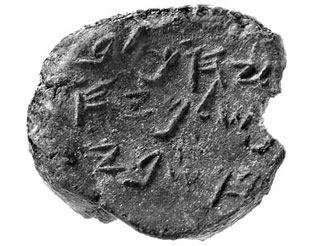
The name of Yehuchal ben Shelemiyahu, a figure mentioned in the Bible, is legible in paleo-Hebrew script on this clay seal impression. Photo credit: Courtesy the Shalem Center
Do you think there were royal scribes in the court of David or Solomon who were recording things for them? Could those writings have become part of the written Bible?
I believe that King David inherited the very developed scribes and administration that were part of Canaanite Jerusalem. And I'm sure that King David was aware of the importance of written documents. He likely took care to have a very detailed archive that contained administrative documents and also included poems, stories, songs, some of which we probably see in the Bible.
"There is still so much to be done in Jerusalem. Ancient Jerusalem really is not revealed yet."
How important to your work is the text of the Bible?
It's the historical source, so important, so fantastically written. The question is, how much of the reality that the Bible describes can we archeologists reveal? Sometimes you find something like the bulla with the name of a minister that appears in the Bible. This happens once in a while. More often you find structures that surely were constructed in ancient times, and the stones, the remains, speak. We need to listen to what they say.
Do you see your work as furthering the legacy of past biblical archeologists?
What we are discovering in Jerusalem now builds on the work of past archeologists, past scholars. I got my first field experience as an archeologist with the famous Professor Shiloh. I was also a student of my grandfather, Professor Benjamin Mazar. He taught me how to observe historical sources, how to examine the archeological remains in light of these historical sources. I learned so much from both of them. And I'm just one part of a long chain. The next generation will continue the work. There is still so much to be done in Jerusalem. Ancient Jerusalem really is not revealed yet.
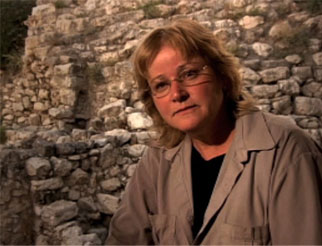
Eilat Mazar continues to excavate in the City of David, each season revealing a fuller picture of the site. Photo credit: © WGBH Educational Foundation
New revelations
[Editor's note: Since producer Gary Glassman interviewed Eilat Mazar in the summer of 2007 for "The Bible's Buried Secrets," her team has made a number of noteworthy discoveries, three of which are detailed below.]
An ancient escape tunnel
Early in 2008, Mazar's team found the entrance of what turned out to be an extensive tunnel running under the Stepped Stone Structure. Mazar believes that the tunnel was likely first created before the time of King David to convey water, and then incorporated into the construction of his palace complex around 1000 B.C. She says there is "high probability" that it is the water tunnel called tsinor in the biblical story of King David's conquest of Jerusalem (in II Samuel 5:6-8 and I Chronicles 11:4-6).
Mazar thinks that, centuries later, the tunnel may have served as an escape route during the Babylonian siege of Jerusalem in 586 B.C. The Bible, in the Second Book of Kings (25:4), describes King Zedekiah's escape through such a tunnel during the siege. The tunnel, with walls composed of unworked stone and bedrock, is wide enough to allow passage of one person crawling through at a time. Within the tunnel, Mazar's team uncovered intact oil lamps characteristic of the siege period.
A second royal seal
Two years after the discovery of the tiny clay bulla, or stamp, bearing the name of Yehuchal ben Shelemiyahu, Mazar's excavation brought to light a similar stamp from the same location. In ancient Hebrew script, it reads "Gedaliah ben Pashur." Ben Pashur's name appears in the same verse of the Book of Jeremiah (38:1) as ben Shelemiyahu's. Both men, according to the Bible, served as ministers in the court of King Zedekiah, who reigned from 597–587/6 B.C., just prior to the destruction of the First Temple and fall of Jerusalem.
The prophet Nehemiah's wall?
In an emergency attempt to shore up an unstable structure at the excavation site, Mazar's team chanced upon another important find—the remnants of a wall that Mazar suspects is related to the prophet Nehemiah, who governed Jerusalem around 445 B.C., following the return of the Israelites from their exile in Babylon. An assemblage of pottery, as well as bullae and arrowheads, helped Mazar date the 100-foot-long wall to Nehemiah's time.
According to the Bible, Nehemiah, both a prophet and political leader, was determined to restore Jerusalem as the Israelites' capital a century after its destruction by the Babylonians, and he directed the construction of an enormous wall near David's former palace in a mere 52 days.
NOTES:
The City of David excavation was sponsored by the Shalem Center in conjunction with the Ir David Foundation, the Israel Antiquities Authority, and The Hebrew University of Jerusalem.
This feature originally appeared on the site for the NOVA program "The Bible's Buried Secrets".
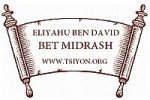









 Our Midrash Marathon Madness Contest
winner for the third week of this Biblical 7th month, is announced in this newsletter, above.
We are getting down to our last week of the contest, so if you
haven't entered yet, now's the time! If calling in is a problem,
send us a sound file - just get your entry in to win a prize. You
could still win our fabulous
Grand Prize, our Silver Kingdom Shekel pendant! As I've said before - It's fun and easy to
enter, so give it a
Our Midrash Marathon Madness Contest
winner for the third week of this Biblical 7th month, is announced in this newsletter, above.
We are getting down to our last week of the contest, so if you
haven't entered yet, now's the time! If calling in is a problem,
send us a sound file - just get your entry in to win a prize. You
could still win our fabulous
Grand Prize, our Silver Kingdom Shekel pendant! As I've said before - It's fun and easy to
enter, so give it a